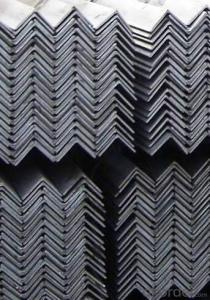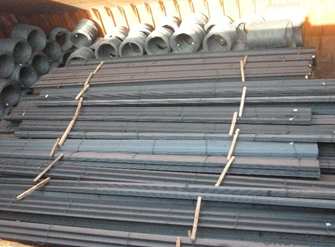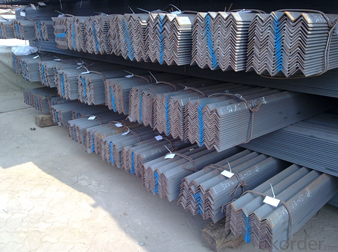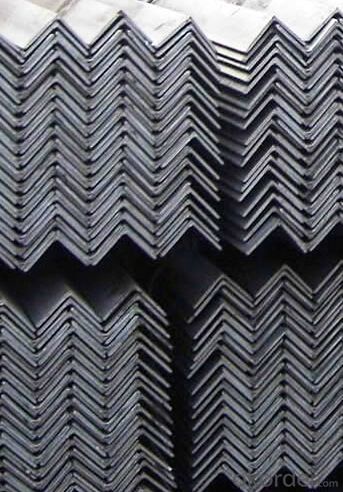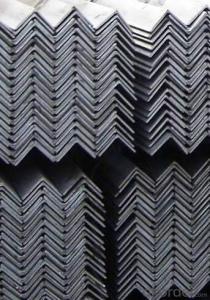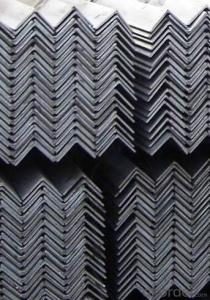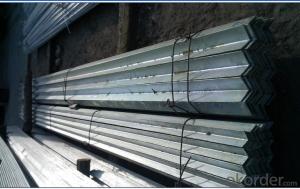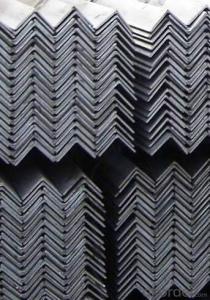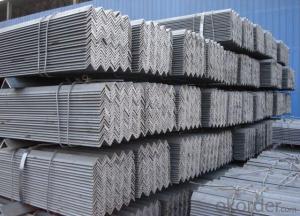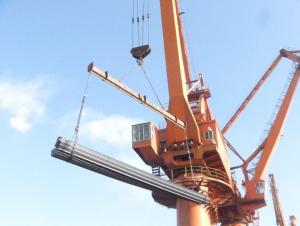HIGH QUALITY GB STANDARD HOT ROLLED ANGLE BAR
- Loading Port:
- Tianjin
- Payment Terms:
- TT OR LC
- Min Order Qty:
- 50 m.t.
- Supply Capability:
- 5000 m.t./month
OKorder Service Pledge
OKorder Financial Service
You Might Also Like
Product Description:
Specifications of Hot Rolled Steel Rebar:
The production process of Steel Rebar
1-Waling beam furnace 2-Roughing rolling group 3-Intermediate rolling train
4-Finishing rolling group 5-Water-cooling device 6-Walking beam cooler
7-Finishing equipment(including the cold scale shear,short feet collection system,
automatic counting device,bundling machine, collect bench)
Usage and Applications of Hot Rolled Steel Rebar:
Deformed bar is widely used in buildings, bridges, roads and other engineering construction. Big to highways, railways, bridges, culverts, tunnels, public facilities such as flood control, dam, small to housing construction, beam, column, wall and the foundation of the plate, deformed bar is an integral structure material. With the development of world economy and the vigorous development of infrastructure construction, real estate, the demand for deformed bar will be larger and larger..
Packaging & Delivery of Hot Rolled Steel Rebar:
Packaging Detail: products are packed in bundle and then shipped by container or bulk vessel, deformed bar is usually naked strapping delivery, when storing, please pay attention to moisture proof. The performance of rust will produce adverse effect.
Each bundle weight: 2-3MT, or as required
Payment terms: TT payment in advance or Irrevocable LC at sight.
Trade terms :FOB, CFR, CIF
Label:to be specified by customer, generally, each bundle has 1-2 labels
Note:
1. Our products are produced according to national standard (GB), if not, supply according to national standards (GB) or agreement as customer required.
2. Other Grade and Standard Deformed Steel Bar we can supply:
Grade: GR40/GR60, G460B/B500A/B500B/B500C,BST500S
Standard: ASTM, BS, DIN
The Minimum Order Quantity of these products is high, and need to be confirmed.
3. We can not only supply Deformed Steel Bar; if you need anything about building materials, please contact us for further information.
4. Please send us your detail specifications when inquire. We will reply to you as soon as possible. We sincerely hope we can establish a long stable business relationship.
- Q: What are the different types of connections used for steel angles in commercial applications?
- In commercial applications, there are several types of connections used for steel angles, depending on the specific requirements and load-bearing capacities of the structure. Some of the common types of connections used for steel angles in commercial applications include: 1. Welded Connections: Welding is a popular method for connecting steel angles in commercial applications. It involves fusing the steel angles together using heat and a filler material. Welded connections provide high strength and rigidity, making them suitable for heavy-duty applications. 2. Bolted Connections: Bolted connections involve using bolts, nuts, and washers to secure the steel angles together. This type of connection offers flexibility and ease of installation. Bolted connections can be easily disassembled and reassembled if needed, making them suitable for structures that may require modification or expansion in the future. 3. Riveted Connections: Riveted connections involve using rivets to join the steel angles. This method is less common in modern commercial applications but was widely used in the past. Riveted connections provide good strength and durability, but they require specialized equipment and skilled labor for installation. 4. Clip Connections: Clip connections are commonly used in light-gauge steel framing systems. They involve using pre-engineered clips that are attached to the steel angles using screws or other fasteners. Clip connections provide a quick and efficient method of assembly, often used in prefabricated structures or systems. 5. Adhesive Connections: Adhesive connections involve using industrial-grade adhesives or epoxy resins to bond the steel angles together. This type of connection offers high strength and can be advantageous in applications where welding or bolting may not be feasible or desirable. It is important to note that the choice of connection method depends on various factors such as the structural requirements, load-bearing capacity, cost, ease of installation, and maintenance considerations. Consulting with a structural engineer or a professional with expertise in steel connections is recommended to ensure the appropriate type of connection is chosen for a specific commercial application.
- Q: What are the different types of steel angles used in material handling systems?
- Material handling systems commonly utilize various types of steel angles for structural support and reinforcement. The following are some examples of the different steel angles used in these systems: 1. Equal Leg Angles: These angles possess equal sides and play a crucial role in providing structural support within material handling systems. Their application is typically seen in scenarios where the load is evenly distributed. 2. Unequal Leg Angles: These angles are characterized by unequal sides. They find utility in material handling systems where the load distribution is not uniform. By offering design flexibility, unequal leg angles enable the system to accommodate different load requirements. 3. L-Shaped Angles: L-shaped angles are frequently employed in material handling systems. They serve to form corners or connect various components together. These angles enhance the system's stability and provide reinforcement, particularly at joints and intersections. 4. Slotted Angles: Slotted angles are versatile steel angles that possess a series of holes along their length. These holes facilitate easy adjustment and customization of the material handling system. They are often utilized in the creation of shelving units, workbenches, and other storage solutions. 5. Perforated Angles: Similar to slotted angles, perforated angles feature a pattern of holes across their surface. These holes enhance ventilation and drainage within the material handling system. Common applications for perforated angles include conveyor systems and storage racks where airflow or liquid drainage is essential. 6. Stainless Steel Angles: Stainless steel angles offer high resistance to corrosion and are prevalent in material handling systems operating in harsh environments or requiring hygienic conditions. They excel in applications that prioritize cleanliness, durability, and rust resistance. These examples highlight just a few of the numerous steel angle types employed in material handling systems. The selection of the appropriate angle depends on specific system requirements such as load capacity, structural integrity, and environmental factors. Consulting a professional engineer or designer is crucial in determining the most suitable steel angle for a material handling system.
- Q: Are steel angles subject to deformation?
- Yes, steel angles are subject to deformation. Steel is a strong and durable material, but it is not immune to the forces that can cause deformation. Deformation can occur in steel angles due to various factors such as excessive loads, bending moments, temperature changes, and improper design or installation. When subjected to these forces, steel angles can experience bending, twisting, or warping, leading to a change in their original shape. To prevent or minimize deformation, engineers and designers can consider factors such as selecting the appropriate steel grade, calculating load capacities, and ensuring proper support and bracing.
- Q: Can steel angles be used for stairs?
- Yes, steel angles can be used for stairs. Steel angles are commonly used as stringers, which are the structural supports for stairs. They provide strength and stability to the staircase and can be a durable and reliable choice for stair construction.
- Q: What are the different types of connections for steel angles?
- There are several different types of connections for steel angles, including bolted connections, welded connections, and clip connections. Bolted connections involve using bolts and nuts to secure the angles together, while welded connections are created by melting the edges of the angles together. Clip connections use specially designed clips to hold the angles in place without the need for welding or bolting. Each type of connection has its own advantages and disadvantages, and the choice of connection method depends on factors such as the load-bearing requirements, ease of installation, and cost.
- Q: What is the typical tolerance for steel angles?
- The specific application and industry standards determine the typical tolerance for steel angles. Generally, the industry standard allows for a tolerance of ±1/8 inch or ±3 millimeters. This means that the actual dimensions of the angle can differ by up to 1/8 inch or 3 millimeters from the specified dimensions. It is worth noting that these tolerances may differ depending on the grade of steel and the manufacturing process used. Consequently, it is vital to refer to the appropriate industry standards or specifications for the specific project in order to ascertain the precise tolerance requirements for steel angles in that particular application.
- Q: What are the different types of surface finishes available for steel angles?
- Steel angles offer a variety of surface finishes, each with its own unique qualities and advantages. Firstly, there is the mill finish, which is the most basic and commonly used surface finish. It showcases the steel in its raw and untreated state, with potential imperfections and roughness. This finish is typically utilized for structural purposes where aesthetics are not a priority. Another option is hot-dip galvanization, where the steel angle is submerged in molten zinc to create a protective coating against corrosion. This finish is ideal for outdoor or corrosive environments, as it offers high resistance to rust. Powder coating is a popular process in which a dry powder is electrostatically applied to the steel angle and then cured under heat. This results in a durable and visually appealing finish that is highly resistant to chipping, scratching, and fading. Powder coated steel angles are commonly seen in architectural and decorative applications. Painting is another possibility, with various types of paint, such as epoxy, enamel, or acrylic, being applied to the steel angle. This not only enhances the appearance but also provides a protective layer. However, painted surfaces may be more prone to chipping and require regular maintenance. For those seeking a naturally smooth and polished surface, stainless steel angles are an excellent choice. These angles are resistant to corrosion and staining, making them suitable for industries like food processing, pharmaceuticals, and marine environments. Lastly, shot blasting is a surface treatment process that involves bombarding steel angles with small metallic or non-metallic particles at high speed. This effectively removes rust, scale, and contaminants, resulting in a clean and roughened finish. Shot blasting prepares the steel angle for subsequent coating or painting. These examples highlight the diverse range of surface finishes available for steel angles. The choice of finish depends on specific requirements such as corrosion resistance, aesthetics, durability, and cost.
- Q: Can steel angles be used as lintels or supports for openings?
- Lintels or supports for openings, such as doors and windows, can be made using steel angles. In construction, steel angles are frequently utilized as structural elements because of their durability and strength. These angles offer the necessary structural support to withstand the weight above the opening. They are commonly installed horizontally, with one leg of the angle resting against the wall on each side. This allows the load from the structure above to be transferred to the steel angle, which then distributes the weight to the surrounding walls. Steel angles are a preferred option for lintels and supports because of their ability to bear heavy loads and resist bending and twisting forces.
- Q: How do steel angles resist corrosion?
- Steel angles resist corrosion through the presence of a protective layer formed on their surface. This layer, known as a patina, is typically composed of iron oxide or iron hydroxide. It acts as a barrier, preventing direct contact between the steel and corrosive elements in the environment, such as moisture or chemicals. Additionally, steel angles can be galvanized or coated with anti-corrosive substances, offering further protection against corrosion.
- Q: Can steel angles be used for structural purposes?
- Steel angles are a viable option for structural purposes. In construction and engineering projects, steel angles have a common application of providing support and stability. They are frequently utilized to reinforce and fortify various structural elements like beams, columns, frames, and trusses. The high strength and durability of steel angles make them capable of enduring heavy loads and forces. They possess versatility as they can be effortlessly welded, bolted, or screwed into position, facilitating convenient installation and adaptation to diverse design specifications. Furthermore, steel angles are accessible in multiple dimensions, lengths, and thicknesses, rendering them appropriate for a broad spectrum of structural uses.
Send your message to us
HIGH QUALITY GB STANDARD HOT ROLLED ANGLE BAR
- Loading Port:
- Tianjin
- Payment Terms:
- TT OR LC
- Min Order Qty:
- 50 m.t.
- Supply Capability:
- 5000 m.t./month
OKorder Service Pledge
OKorder Financial Service
Similar products
Hot products
Hot Searches


